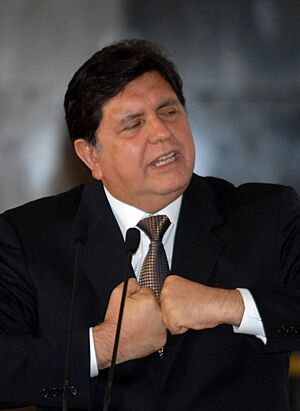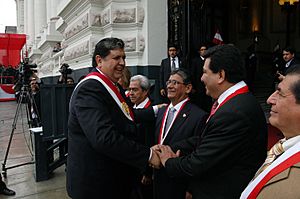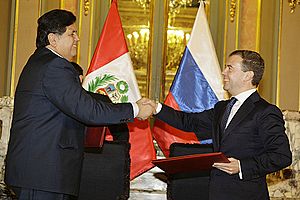Alan García facts for kids
Quick facts for kids
Alan García
|
|
|---|---|
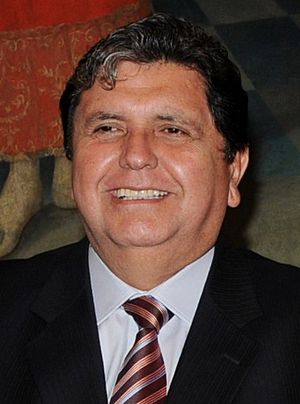
García in 2010
|
|
| 53rd and 57th President of Peru | |
| In office 28 July 2006 – 28 July 2011 |
|
| Prime Minister | Jorge Del Castillo Yehude Simon Javier Velásquez José Antonio Chang Rosario Fernández |
| Vice President | 1st Vice President Luis Giampietri 2nd Vice President Lourdes Mendoza |
| Preceded by | Alejandro Toledo |
| Succeeded by | Ollanta Humala |
| In office 28 July 1985 – 28 July 1990 |
|
| Prime Minister | Luis Alva Castro Guillermo Larco Cox Armando Villanueva Luis Alberto Sánchez |
| Vice President | 1st Vice President Luis Alberto Sánchez 2nd Vice President Luis Alva Castro |
| Preceded by | Fernando Belaúnde |
| Succeeded by | Alberto Fujimori |
| Senator for Life as Former President of the Republic |
|
| In office 28 July 1990 – 5 April 1992 |
|
| Member of the Chamber of Deputies | |
| In office 26 July 1980 – 26 July 1985 |
|
| Constituency | Lima |
| Member of the Constituent Assembly | |
| In office 28 July 1978 – 13 July 1979 |
|
| President of the Peruvian Aprista Party | |
| In office 7 June 2004 – 17 April 2019 |
|
| Preceded by | Position reestablished |
| Succeeded by | César Trelles |
| In office 15 July 1985 – 23 December 1988 |
|
| Preceded by | Position established |
| Succeeded by | Position abolished |
| General Secretary of the Peruvian Aprista Party |
|
| In office 15 February 1992 – 23 December 1992 |
|
| Preceded by | Luis Alva Castro |
| Succeeded by | Agustín Mantilla |
| In office 9 October 1982 – 15 July 1985 |
|
| Preceded by | Fernando León de Vivero |
| Succeeded by | Armando Villanueva |
| Personal details | |
| Born |
Alan Gabriel Ludwig García Pérez
23 May 1949 Lima, Peru |
| Died | 17 April 2019 (aged 69) Lima, Peru |
| Political party | Peruvian Aprista |
| Other political affiliations |
Popular Alliance (2015–2016) |
| Height | 1.88 m (6 ft 2 in) |
| Spouses | Carla Buscaglia (divorced) Pilar Nores
(m. 1978) |
| Children | 6 |
| Alma mater | Pontifical Catholic University of Peru National University of San Marcos (LLB) Complutense University Pantheon-Sorbonne University (MA) Universidad de San Martín de Porres (MA) |
| Signature |  |
Alan Gabriel Ludwig García Pérez (born May 23, 1949 – died April 17, 2019) was a Peruvian politician. He served as President of Peru two times. His first term was from 1985 to 1990, and his second was from 2006 to 2011.
García was a key leader of the Peruvian Aprista Party (APRA). He was the only member of this party to become president. He was guided by the party's founder, Víctor Raúl Haya de la Torre. García was elected to the Constituent Assembly of Peru in 1978. He then became a member of the Peruvian Congress in 1980. In 1982, he became the General Secretary of the APRA party. He was first elected president in 1985 when he was just 35 years old.
His first time as president faced big economic problems and social unrest. After his first term, there were questions about his actions and how money was handled. In 1992, he left Peru and lived in Colombia and France for nine years. After the government changed in Peru, he returned to politics. He ran for president again in 2001 but lost. In 2006, he was elected president for a second time. Many people saw this as a surprising comeback.
During his second term, Peru's economy grew steadily. It became one of the fastest-growing countries in Latin America. Poverty in Peru also went down a lot. Peru also signed important trade agreements with the United States and China. However, questions about money and government actions continued during and after his time in office. He left politics after the 2016 election, where he did not win enough votes to continue. Alan García passed away on April 17, 2019. He is remembered as a very talented and charismatic speaker in Peru's history.
Contents
Early Life and Education
Alan García was born in Lima, Peru. He met his father for the first time when he was five years old. His father had been imprisoned because he was a member of the Peruvian Aprista Party. García's mother helped start the party in her home region. From a young age, he went to party meetings with his father. He met future leaders of the American Popular Revolutionary Alliance (APRA) party.
At 14, he was already a very good speaker. He gave a speech honoring Víctor Raúl Haya de la Torre, the party founder. García studied law at two universities in Peru. In 1972, he went to Spain to study constitutional law. He later moved to France to study sociology.
In 1978, he was asked to return to Peru to run for the Constituent Assembly. García was elected and impressed others with his speaking skills. After Haya de la Torre died in 1979, García was put in charge of the party's public affairs.
García had one daughter, Carla, from his first marriage. She is also involved in Peruvian politics. With his second wife, Pilar Nores, he had four children. They separated in 2010.
In 1980, he was elected to Congress. Two years later, he became the General Secretary of the Peruvian Aprista Party. In 1985, he was elected president of Peru.
First Presidency (1985–1990)
García won the presidential election on April 14, 1985. He received 45% of the votes. Since he didn't get 50%, a second election was planned. However, the other candidate, Alfonso Barrantes, decided not to run again. So, García was declared President on June 1 and took office on July 28, 1985. He was 36 years old, making him one of the youngest presidents in Latin America at the time. This was the first time the APRA party came to power in Peru.
His economic plans aimed to distance Peru from international markets. This led to less investment in the country. His time in office was marked by very high inflation, meaning money quickly lost its value. By 1990, prices had risen by a huge amount, which hurt Peru's economy. The Peruvian currency had to be changed twice because it lost so much value.
Poverty increased during his presidency. García also tried to take control of banks and insurance companies for the government. The International Monetary Fund and other financial groups were concerned when Peru limited how much it would pay back on its debts. This made it harder for Peru to get money from international markets.
The economic problems made social tensions worse. This helped the rise of violent groups like the Shining Path and the Túpac Amaru Revolutionary Movement (MRTA). These groups caused a lot of violence in Peru. The government tried to stop them with military force. There were also questions about human rights during this time. Some people disappeared, and there were killings during prison riots. The exact details of García's involvement in these events are not clear.
After his first term, there were many questions and investigations about how money was handled during his time in office. These investigations looked into whether he had gained wealth improperly. Later, the Supreme Court of Peru stopped some of these investigations, allowing him to return to Peru after his exile.
Exile (1992–2001)
On April 5, 1992, President Alberto Fujimori took control of the government. He closed the Peruvian Congress and changed other public institutions. Many politicians were targeted. García had been serving as a senator, but his duties were suspended due to investigations. The Supreme Court later dropped the charges against him, and he returned to the Senate in March 1992.
After Fujimori's actions, García went into hiding. He then sought political asylum in the Colombian Ambassador's residence. Colombia granted his request, and he left Peru for Bogotá. He promised to fight against Fujimori's government from abroad. The Peruvian government tried to get him back, but Colombia refused.
In 1994, the Human Rights Commission of the Organization of American States said that Fujimori's government had violated Alan García's rights. They asked Peru to cancel the investigations against him. In 1995, the Peruvian Congress removed García's special protection as a former president. This was because of new accusations that he had received money illegally for building the Lima Metro. The Supreme Court again asked Colombia to send him back, but García moved to Paris, France, for the rest of his exile.
During his time in exile, from 1993 to 2001, Alan García did not take an active part in Peruvian politics. He wrote some books about his first presidency and other topics. He also spoke out against human rights problems under the Fujimori government. In 2001, the Supreme Court officially canceled the earlier accusations against him.
Return to Politics
2001 Peruvian Election
Alan García returned to Lima on January 27, 2001. Many supporters were waiting for him at the airport. That evening, he gave a speech to a large crowd in Lima. He ran for president in the new elections. In a short 60-day campaign, he came in second place in the first round. This meant he would go to a second round against Alejandro Toledo.
García offered new ideas, but he did not get enough support from voters. Alejandro Toledo won the election in the second round with 53.1% of the votes, while García received 46.9%. After the election, García became the leader of the opposition as head of the APRA party.
2006 Peruvian Election
García officially started his campaign for the April 2006 presidential election. Ollanta Humala won the first round, and García came in second. Since no one won a majority, a second election was held on June 4, 2006, between Humala and García. García won the second round.
Before the second round, García had a disagreement with Venezuelan President Hugo Chávez. Chávez supported Ollanta Humala and spoke negatively about García. García responded by saying Chávez was not acting like a leader and challenged him to a debate. García also asked the Organization of American States to get involved.
A few days before the election, García's economic adviser said that if García won, his government would continue to work with the International Monetary Fund. The IMF responded positively to this news.
Second Presidency (2006–2011)
On July 28, 2006, Alan García became president again. He won about 53% of the votes. During his second term, he worked to improve his reputation after the challenges of his first term.
He won votes mainly in Lima and the northern coast, where his party had strong support. He lost in the southern and rainforest areas. Many Peruvians voted for him because they were worried about his opponent, Ollanta Humala. They feared Humala might lead Peru towards a government like Cuba or be too influenced by Venezuela's Hugo Chávez. Humala denied these rumors, but the concerns helped García win.
A month before García took office, his party helped approve a trade agreement with the United States in the Peruvian Congress. This agreement came into effect in 2009.
In his first speech as president, García said he would choose a Finance Minister who was not too extreme in their economic views. Jorge Del Castillo became the prime minister. García also said he admired Brazilian President Lula da Silva and was interested in a trade agreement with Brazil.
García acknowledged that Humala's support in the election was important. He said a president should talk with different political groups. However, Humala said he would lead the main opposition group to protect the country's interests.
President Chávez of Venezuela continued to criticize García. García responded by telling Chávez to "accept your defeat in silence." Later, García and Chávez ended their disagreement at a meeting of South American leaders.
On July 20, 2006, García named Luis Carranza as finance minister. This choice was welcomed by some who had criticized García's economic policies during his first term. However, some labor unions were concerned that García might not change economic policy as much as they hoped.
On the day before his inauguration, García announced his cabinet. This included Jorge del Castillo as prime minister and Luis Carranza as finance minister.
García faced a challenge on January 11, 2007. His idea to bring back the death penalty for captured Shining Path rebels was rejected by Congress. He had promised this during his election campaign. Congress members said it would go against international human rights agreements.
On June 5, 2009, García ordered police and military to stop indigenous protesters in the Bagua region. The protesters were blocking roads because they were against new laws. These laws allowed foreign companies to use indigenous lands for oil, mining, and logging. This event led to many deaths among both civilians and police officers.
Over time, studies on human rights in Peru have shown a connection between García and efforts to protect people who violated human rights. This included appointing judges who might be sympathetic to them. García was also critical of judges who tried to bring human rights violators to justice. During his presidency, García tried to make it easier for the military and harder for groups that help victims of human rights violations.
Foreign Affairs
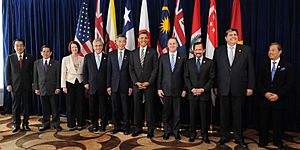
After being elected, García worked to improve Peru's relationship with Chile. He met with Chilean President Michelle Bachelet, and they made some agreements. These talks led to an important economic agreement with Chile.
On November 9, 2006, García signed 12 trade agreements with Brazilian President Luiz Inácio Lula da Silva. This strengthened the relationship between the two countries. These agreements aimed to increase cooperation. García also offered Peru's water power to help meet Brazil's energy needs.
After Presidency (2011–2019)
After his second term, García offered to help the new president of Peru. He also wrote articles about his ideas for Peru. These ideas focused on reducing poverty, increasing foreign investment, and growing Peru's economy with social care.
In 2014, he criticized a salary increase for government ministers. He had cut his own cabinet members' salaries during his presidency.
García ran for president a third time in the 2016 Peruvian general election. He was part of the Popular Alliance group. He did not get enough votes to go to the second round of the election. Pedro Pablo Kuczynski was eventually elected president.
Public Image
In 2008, García was named "leader of the year" by Latin Business Chronicle. At that time, Peru was seen as one of the best countries in Latin America for business.
Awards and Recognitions
- Doctor Honoris Causa - University of Delhi (1987)
Published Works
García wrote several books about Peru and Latin America. Some of his published works include:
- 1981: A la Inmensa Mayoría: Discursos
- 1982: El Futuro Diferente
- 1987: El Desarme Financiero: Pueblo y Deuda en América Latina
- 1990: La Revolución Regional
- 1991: La Defensa de Alan García
- 1992: El Nuevo Totalitarismo
- 1994: El Mundo de Maquiavelo
- 1997: La Falsa Modernidad
- 1997: Siete Tesis Erróneas del Neoliberalismo en América Latina
- 1999: Mi Gobierno Hizo la Regionalización
- 2000: La Década Infame: Deuda Externa 1990–1999
- 2003: Modernidad y Política en el Siglo XXI: Globalización con Justicia Social
- 2005: Sierra Exportadora: Empleo, Modernidad y Justicia en Los Andes
- 2011: Contra el Temor Económico: Creer en el Perú
- 2012: Pida la Palabra: Por la Libertad, la Plenitud y el Exito
- 2012: Pizarro, el Rey de la Baraja: Política, confusión y dolor en la Conquista
- 2013: Noventa años de aprismo: Hay, hermanos, muchísimo que hacer
- 2013: Confucio y la globalización: Comprender China y crecer con ella
- 2014: Sierra Exportadora: La creación de la Alianza del Pacífico
- 2015: Obras completas IX volúmenes
- 2019: Metamemorías
Images for kids
-
Alan García and Spanish Prime Minister Felipe González at Moncloa Palace, January 1987.
-
Alan García and George W. Bush at the White House in October 2006.
See also
 In Spanish: Alan García para niños
In Spanish: Alan García para niños
- First presidency of Alan García
- Second presidency of Alan García



